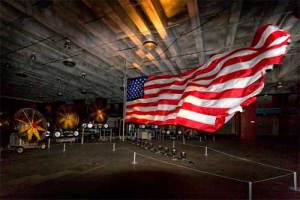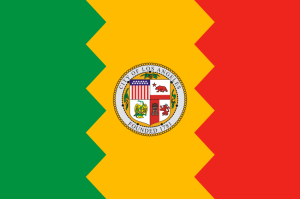LA hosts ragged flag and has municipal flag

The Museum of Contemporary Art in Los Angeles, a city that has a municipal flag, recently hosted an unusual art installation by the oddly named William Pope.L. It was a gigantic American flag with elongated red-and-white stripes that were torn into individual strips.
The artist told The New York Times that his work represented “one possible fate of America….There are cracks in the seams of what we are….If anyone thinks I’m besmirching or making fun of the flag, I should say that I don’t share their idea of patriotism….[If] the flag is as strong and resilient as they say it is, it should be able to stand up to this. This doesn’t mean I don’t love my country. I’m asking questions of it.”
Continuing his explanation, he said that “this project is a chance for people to feel the flag. People need to feel their democracy, not just hear words about it. For me, democracy is active, not passive….I am showing something that’s always been true. The American flag is not a toy. It’s not tame. It’s bright, loud, bristling and alive.”

The Los Angeles municipal flag is also very bright as well as extraordinarily complex, crammed with symbols and stuffed with images. Three thick, vertical segments with jagged edges – green, yellow and red – divide the banner. In the middle stripe sits the city’s circular seal, which was adopted 110 years ago. Atop the seal, the words “City of Los Angeles” appear; below, it says, “Founded 1781.”
But that’s only the beginning of the complexity of the city’s seal and municipal flag. They are freighted with multiple symbols, including four animals, which reflect the history of Los Angeles:
 *Stars and stripes indicate LA’s location as a U.S. city;
*Stars and stripes indicate LA’s location as a U.S. city;
*Olive, grape and orange sprays celebrate the agricultural abundance of southern California; and
*A circle of 77 black beads represents a Rosary, indicative of the Roman Catholic missionaries who came to California.
As for the four animals, they include:
*A bear, copied from the California state flag;
*A crowned lion, standing on its hind legs, reflective of the Spanish history of the city;
*An eagle with a serpent in its mouth alongside a castle to indicate the Mexican influence on the city. The image is derived from the Arms of Mexico.
Perhaps L.A. should stand for “Lots of Animals.”

FYI – my maternal grand mother was Elsie Jorss Reilley. We knew her National Anthem story while growing up. I live in Fairfax County, VA. I have been doing genealogy for about a year on my family lines – which includes Jorss, Reilley, Oristian, and others. Elsie’s parents were German-Americans as the author notes. Elsie’s father – Amandus Jorss – was a member of the Saengerbund – a German-American singing and cultural organization – with a branch in Washington, DC. This likely had a major influence on Elsie’s enthusiasm for singing. Washington, DC had a very large German immigrant population in the later 1800’s and early 1900’s. cheers – Tom Oristian